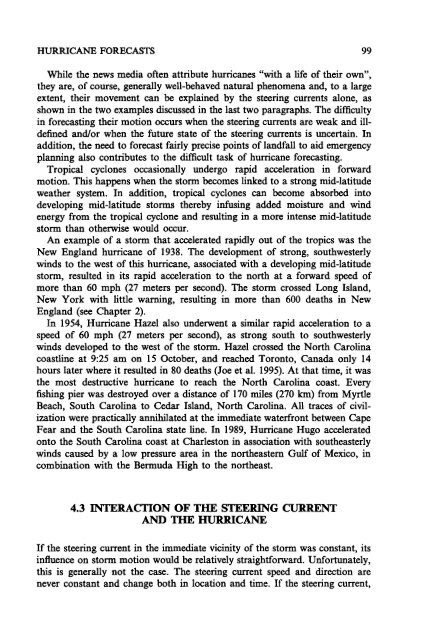Hurricanes: Their Nature and Impacts on Society - Climate Science ...
Hurricanes: Their Nature and Impacts on Society - Climate Science ...
Hurricanes: Their Nature and Impacts on Society - Climate Science ...
You also want an ePaper? Increase the reach of your titles
YUMPU automatically turns print PDFs into web optimized ePapers that Google loves.
HURRICANE Fa RECASTS<br />
While the news media often attribute hurricanes "with a life of their own",<br />
they are, of course, generally well-behaved natural phenomena <str<strong>on</strong>g>and</str<strong>on</strong>g>, to a large<br />
extent, their movement can be explained by the steering currents al<strong>on</strong>e, as<br />
shown in the two examples discussed in the last two paragraphs. The difficulty<br />
in forecasting their moti<strong>on</strong> occurs when the steering currents are weak <str<strong>on</strong>g>and</str<strong>on</strong>g> illdefined<br />
<str<strong>on</strong>g>and</str<strong>on</strong>g>/or when the future state of the steering currents is uncertain. In<br />
additi<strong>on</strong>, the need to forecast fairly precise points of l<str<strong>on</strong>g>and</str<strong>on</strong>g>fall to aid emergency<br />
planning also c<strong>on</strong>tributes to the difficult task of hurricane forecasting.<br />
Tropical cycl<strong>on</strong>es occasi<strong>on</strong>ally undergo rapid accelerati<strong>on</strong> in forward<br />
moti<strong>on</strong>. This happens when the storm becomes linked to a str<strong>on</strong>g mid-latitude<br />
weather system. In additi<strong>on</strong>, tropical cycl<strong>on</strong>es can become absorbed into<br />
developing mid-latitude storms thereby infusing added moisture <str<strong>on</strong>g>and</str<strong>on</strong>g> wind<br />
energy from the tropical cycl<strong>on</strong>e <str<strong>on</strong>g>and</str<strong>on</strong>g> resulting in a more intense mid-latitude<br />
storm than otherwise would occur.<br />
An example of a storm that accelerated rapidly out of the tropics was the<br />
New Engl<str<strong>on</strong>g>and</str<strong>on</strong>g> hurricane of 1938. The development of str<strong>on</strong>g, southwesterly<br />
winds to the west of this hurricane, associated with a developing mid-latitude<br />
storm, resulted in its rapid accelerati<strong>on</strong> to the north at a forward speed of<br />
more than 60 mph (27 meters per sec<strong>on</strong>d). The storm crossed L<strong>on</strong>g Isl<str<strong>on</strong>g>and</str<strong>on</strong>g>,<br />
New York with little warning, resulting in more than 600 deaths in New<br />
Engl<str<strong>on</strong>g>and</str<strong>on</strong>g> (see Chapter 2).<br />
In 1954, Hurricane Hazel also underwent a similar rapid accelerati<strong>on</strong> to a<br />
speed of 60 mph (27 meters per sec<strong>on</strong>d), as str<strong>on</strong>g south to southwesterly<br />
winds developed to the west of the storm. Hazel crossed the North Carolina<br />
coastline at 9:25 am <strong>on</strong> 15 October, <str<strong>on</strong>g>and</str<strong>on</strong>g> reached Tor<strong>on</strong>to, Canada <strong>on</strong>ly 14<br />
hours later where it resulted in 80 deaths (Joe et al. 1995). At that time, it was<br />
the most destructive hurricane to reach the North Carolina coast. Every<br />
fishing pier was destroyed over a distance of 170 miles (270 km) from Myrtle<br />
Beach, South Carolina to Cedar Isl<str<strong>on</strong>g>and</str<strong>on</strong>g>, North Carolina. All traces of civilizati<strong>on</strong><br />
were practically annihilated at the immediate waterfr<strong>on</strong>t between Cape<br />
Fear <str<strong>on</strong>g>and</str<strong>on</strong>g> the South Carolina state line. In 1989, Hurricane Hugo accelerated<br />
<strong>on</strong>to the South Carolina coast at Charlest<strong>on</strong> in associati<strong>on</strong> with southeasterly<br />
winds caused by a low pressure area in the northeastern Gulf of Mexico, in<br />
combinati<strong>on</strong> with the Bermuda High to the northeast.<br />
4.3 INTERACnON OF nm STEERING CURRENT<br />
AND nm HURRICANE<br />
If the steering current in the immediate vicinity of the st<strong>on</strong>n was c<strong>on</strong>stant, its<br />
influence <strong>on</strong> st<strong>on</strong>n moti<strong>on</strong> would be relatively straightforward. Unfortunately,<br />
this is generally not the case. The steering current speed <str<strong>on</strong>g>and</str<strong>on</strong>g> directi<strong>on</strong> are<br />
never c<strong>on</strong>stant <str<strong>on</strong>g>and</str<strong>on</strong>g> change both in locati<strong>on</strong> <str<strong>on</strong>g>and</str<strong>on</strong>g> time. If the steering current,<br />
99














